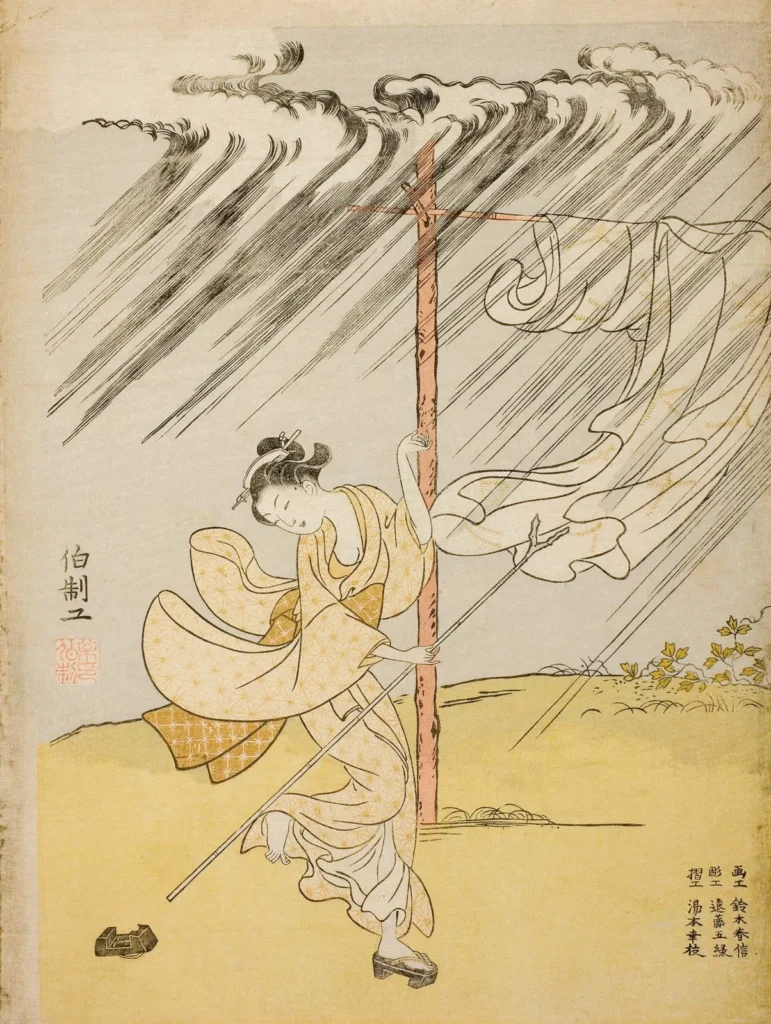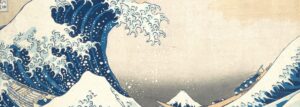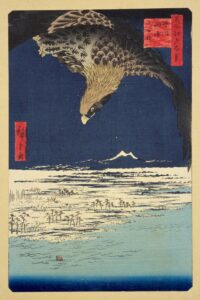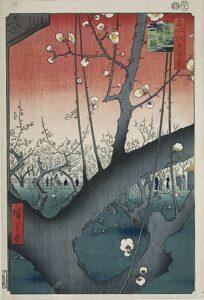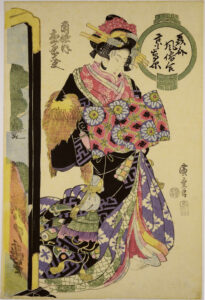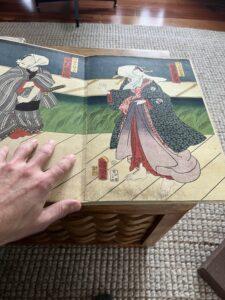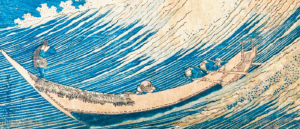Nishiki-e is an Edo specialty unrivaled by other regions. Those prints that are gorgeously colored find fans of high status. They are admired throughout Japan. – Edo meisho zue (1834) [2]
Nishiki-e – meaning “brocade paintings” in Japanese refers to an era of polychromatic prints that practically revolutionized how Japanese woodblock prints were made. Usually, a number of colors are employed in every single one of these prints, with separate blocks carved especially for each color. Registration marks called kento were used to mark these separate areas. So let’s dive into how these prints first came into being. And what’s even more interesting, is that nishiki-e art pieces were always much cheaper than the average ukiyo-e prints – about the price of a noodle soup in Edo [1].
The nishiki-e category’s bloom can be attributed to the printmaker Suzuki Harunobu who first brought colored prints to life in the 1760s. With his keen sense of color and a distinct appreciation for intricacy and subtlety in his prints, he took Japanese woodblock art to a much higher level than before. Take the Parading Courtesan for example – Harunobu piece that’s one of a kind. Laced with orange, greens, reds, and yellows, the print has four females with spectacular detail in their kimonos and hairstyles – a trait attributed to multi-colored ukiyo-e prints [3].
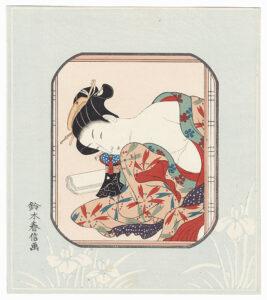
Now how did this transition happen from completely colorless, black prints to these multi-colored ones? [3]
Let’s give you a little bit of backstory. For quite a while during the Edo period, Japanese woodblock prints were solely made out of black ink and were known as sumizuri-e. As a matter of fact, you could say that they were just outlines and finely carved sketches with little to no color in them [4].
Gradually, these prints began to transition to other colored inks, like Beni-e red prints and Aizuri-e blue prints or even Urushi-e prints where a gloss-like layer was applied to the print to make them look rather fresh and new for a long time. Later, prints with two or three colors, such as the Benizuri-e began to come forth, i.e. prints that have both green and red tones to them. And that was followed by a bloom of color when Harunobu brought forth the idea of making several woodcuts, each for a different color in the print. And these prints began to have 8 to 10 colors in the same print – coined as the Nishiki-e prints [3].
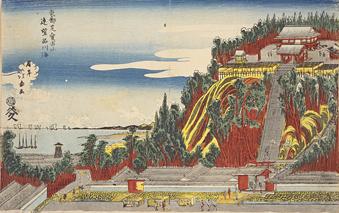
And following Suzuki Harunobu, several artists within the Edo period began making these colorful prints as the prime ukiyo-e. Among others, Katsushika Hokusai, the legend known for the Great Wave Off Kanagawa began incorporating more color in his prints [4].
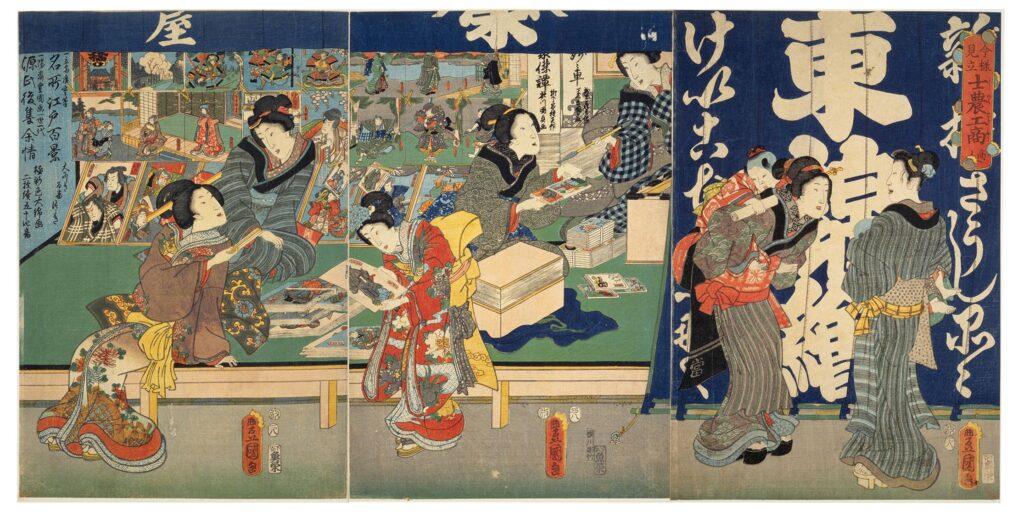
Take this print for example, from the 36 Views of Mt. Fuji. Not only is there a blend of white, blue, and beige, but you see several different shades of blue laced with black on the grass, a feat that would’ve only been possible with multiple carved pieces of wood, each dipped in a separate colored ink. This is what the true beauty of nishiki-e looks like, hence the name meaning “brocade paintings” [3].
This whole idea of making multi-colored prints was one of the ukiyo-e concepts that extended beyond just the Edo period. Particularly during the Meiji period and the era of the Shin-Hanga movement to save Japanese woodblock prints, these prints were the front-runners of this movement [4].
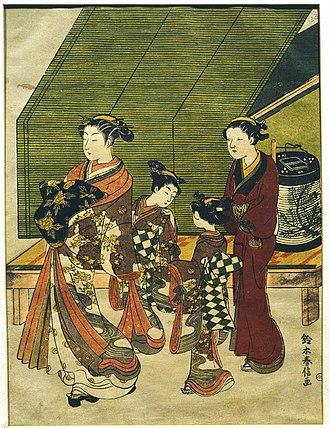
All in all, these prints constitute what modern Japanese woodblock prints look like and you’d probably come across a whole bunch of them when you collect, buy or sell Japanese woodblock prints out in the wild.
To find original Edo-period Nishiki-e woodblock prints to purchase of your own, be sure to browse our current selection for sale by clicking here.
Do you have a beautiful Nishiki-e woodblock print for sale, say maybe an original Hokusai?! Please get in touch if you would like an appraisal or any help selling your woodblock print. Click HERE.
Links
[1]“Nishiki-e: Edo’s Information Media: Jihon and Ezōshi: Edo Tokyo Digital Museum – Historical Visit, New Wisdom.” TOKYO METROPOLITAN LIBRARY, https://www.library.metro.tokyo.lg.jp/portals/0/edo/tokyo_library/english/bungei/page4-1.html.
[2] “Nishiki-e Defined.” Fanning the Flames: Propaganda in Modern Japan, https://fanningtheflames.hoover.org/shorthand-story/5.
[3] “Woodblock Printing.” Japanese Woodblock Prints – Nishiki-e, https://marina-hg.github.io/iffall2017/microsite/www/nishiki-e.html.
[4] What Are Nishiki-e?|Prints of Actors|Kabuki for Beginners, https://www2.ntj.jac.go.jp/dglib/contents/learn/edc25/en/woodblock-prints/nishiki-e.html.

